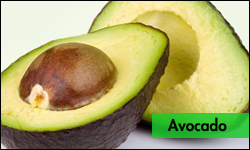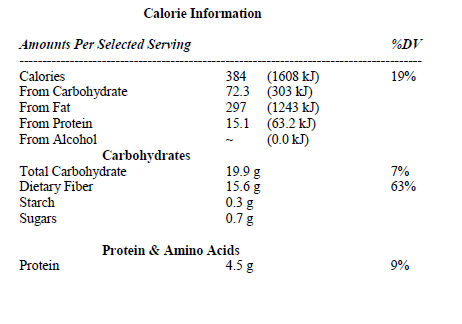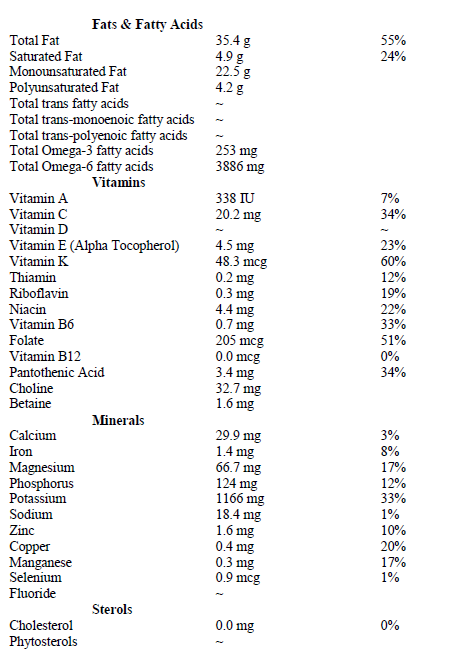Back to > Major Fruits | Minor Fruits | Underutilized Fruits
![]()
 |
||
|
|
||
Nutritive components: Avocado is surprisingly a complete food, with fourteen minerals to stimulate growth, including iron and copper for the blood. The sodium and potassium in avocados keeps the body chemically balanced, and their low sugar and cholesterol content and absence of starch make them an ideal fruit (with Estimated Glycemic Load, eGL = 4; Inflamation Factor Rating, IF = 181) for diabetics or hypoglycemics (choose small slices throughout the day to keep the sugar balanced).Vitamins in avocados include A, several B-complex, C, and E, as well as phosphorus and magnesium. They’re also a great source of antioxidants like vitamins E and C. Because of their density, avocados, like bananas, are filling. But they are also a perfectly digestible slow-burning fuel, making them ideal for replenishing nutrients for athletes. They’re a great source of fruit oil and digestible fats, and they make excellent and healthy dips for raw vegetables. When blended with fruit, they make particularly nutritious baby food. Avocados, despite being high in fat have many health promoting properties; have a fat content of between 71 to 88% of their total calories – about 20 times the average for other fruits. A typical avocado contains 30 g of fat, but 20 g of these fat are health-promoting monounsaturated fats, especially oleic acid. They are an excellent food for weight loss as well.A good source of vitamin K, dietary fiber, vitamin B6, vitamin C, folate, copper, and contain more potassium than a medium banana- 877 g of potassium (regulation of blood pressure) in one avocado than 470 g in a banana. They are rich in B vitamins, vitamin E (antioxidant), vitamin K, sugar free and cholesterol free. They have the highest fiber content of any fruit – including 75% insoluble and 25% soluble fiber; rich source of the antioxidant, glutathione, which has been found to be active against 30 different disorders
Health Benefits:
- The avocado’s high levels of Vitamin E are known to help slow the aging process and help to protect against disease.
- The avocado is rich in folate, effective in maintaining good heart health.
- They contain 26% of the recommended daily intake for pregnant women. By increasing the consumption of folate before conception and during the first 3 months of pregnancy, the risk of abnormalities, such as spina bifida, is greatly reduced.
- Avocados are the highest fruit source of lutein, a physiochemical that helps to protect against cataracts and macular degeneration, the leading cause of blindness in the elderly
Source: http://www.nutritiondata.com/facts/fruits-and-fruit-juices/1844/2
Important phytochemicals: A fatty triol (fatty alcohol) with one double bond, avocadene (16-heptadecene-1, 2, 4-triol), is found in avocado.
Reference:
- Adame, E.L. 1994. Plagas del aguacate y su control. IV Curso de Aprobación Fitosanitaria en Aguacate. Facultad de Agrobiología. U. M. S. N. H. Uruapan, Michoacán, México.
- Armstrong, WP (2000). “Fruits Of The Rose, Olive, Avocado & Mahagany Families – Laurel Family: Lauraceae Extract from: http://waynesword.palomar.edu/ecoph17.htm#avocado
- “Avocados, raw, California”. NutritionData.com (2007). Retrieved on 2007-12-29
- Bailey, B.J., and P.M. Hoffman. 1980. Amorbia: ACalifornia avocado insect pest. Department of Entomology,University ofCalifornia, División of Agricultural Sciences. Leaflet 21256Riverside, Ca.U.S.A.
- Boyle, E.M. (1980). Vascular anatomy of the flower, seed, and fruit of Lindera benzoin. Bull. Torreya Bot. Club. 107:409-417.
- Bravo, M.H., et al., 1988. Plagas de frutas. Centro de Entomología y Acaralogía , Colegio de Posgraduados. Montecillo, México pp 49-236
- Bruno Razeto, Jose Longueira, and Thomas Fichet. (1992). Proc. ofSecond World Avocado Congress 1992 pp. 273-279
- California Avocado Comission (2007). Avocado.org. Retrieved March 1, 2007, Web site: http://www.avocado.org/
- Davenport, T.L. Avocado Flowering, Hort. Reviews 8: 257-289.
- Dowling, Curtis F.; Morton, Julia Frances (1987). Fruits of warm climates. Miami, Fla: J.F. Morton.
- “FATTY ALCOHOLS: Unsaturated alcohols”. CyberlipidCenter. Retrieved on 2007-12-29.
- Hirokazu Kawagishi, Yuko Fukumoto, Mina Hatakeyama, Puming He, Hirokazu Arimoto, Takaho Matsuzawa, Yasushi Arimoto, Hiroyuki Suganuma, Takahiro Inakuma, and Kimio Sugiyama. (2001). Liver Injury Suppressing Compounds from Avocado (Persea americana). J. Agric. Food Chem., 49 (5), 2215 -2221, 2001. 10.1021/jf0015120 S0021-8561(00)01512-0
- Koch, F.D. (1983). Avocado Grower’s Handbook, Bonsall Publications,
- López, E. 1990. Manejo de plagas de palta. In the international course: “Producción, Postcosecha y Comercialización de Paltas”. Facultad de Agronomía. Universidad Católica de Valparaíso. Viña del Mar, Chile.
- López-López, L., and Cajuste-Bontemps, J.F. 1999. Efecto del envase de carton corrugado y embalaje en la conservación de la calidad de fruta de aguacate CV. Hass. Revista Chapingo Serie Horticultura 5 Núm. Especial: 359-364.
- Martínez, B.R., and Adame, E.L. 1987. El minador de la hojadel aguacatero, dinámica de población, biología y control. Revista: Fruticultura de Michoacán. Año II, (I), 11pp. 5-26.Uruapan Michoacán.
- Minas K. Papademetriou (2000). Avocado Production in Asia and the Pacific. FOOD AND AGRICULTURE ORGANIZATION OF THE UNITED NATIONS
- REGIONAL OFFICE FOR ASIA AND THE PACIFIC
- BANGKOK,THAILAND, JULY 2000
- Naveh E, Werman MJ, Sabo E, Neeman I (2002). “Defatted avocado pulp reduces body weight and total hepatic fat but increases plasma cholesterol in male rats fed diets with cholesterol”. J. Nutr. 132 (7): 2015–8.
- Ohr, H. D. , M. D. Coffer, and R. T. McMillan, Jr. (2003) Diseases of Avocado (Persea americana Miller). http://www.apsnet.org/online/common/names/avocado.asp
- Ojewole JA, Amabeoku GJ. (2006). Anticonvulsant effect of Persea americana Mill (Lauraceae) (Avocado) leaf aqueous extract in mice. Phytother Res, 20(8): 696-700.
- SAGAR Secretaría de Agricultura, Ganadería y Desarrollo Rural. 1999. Revista “Claridades Agropecuarias”, No. 65 “El Aguacate”. Enero de 1999.
- Sánchez-Pérez, J. 2001. Aguacate en postcosecha. Boletín informativo de la APROAM El Aguacatero No. 5, http://www.aproam.com/aguacater5.htm SARH-DGSV. 1981. Lista de insectos y ácaros perjudiciales a los cultivos de México. 2a. Ed. Secretaría de Agricultura y Recursos Hidráulicos – Dirección General de Sanidad Vegetal. Fitófilo, No. 86: 1-196.
- Scora, Rainer. W. and Bergh, B. (1990). THE ORIGINS AND TAXONOMY OF AVOCADO (PERSEA AMERICANA) MILL. LAURACEAE. Acta Hort. (ISHS) 275:387-394
- Thorp, T.G. (1992). A study of modular growth in avocado (Persea americana Mill.) PhD.Dissertation. The University ofAdelaide,South Australia.
- Whiley, A.W. and B. Schaffer. (1994). Avocado, p. 3–35. In: B. Schaffer and P.C. Andersen (eds.). Environmental physiology of fruit crops. vol. 2. Sub-tropical and tropical crops. CRC Press Inc.,Boca Raton,Fla.
- Wikipedia, (2007). Avocado. Retrieved March 5, 2007, from Wikipedia Web site: http://en.wikipedia.org/wiki/Avocado
- Yahia, E.M. 2001. Manejo postcosechadel aguacate, In: Memoria del 1er. Congreso Mexicano y Latinoamericanodel Aguacate.Uruapan, Michoacán, México. Octubre 2001.
- Yahia, E. 2003. Manejo postcosechadel aguacate, 2ª. Parte. Boletín informativo de APROAM El Aguacatero, Año 6, Número 32, Mayo de 2003.


